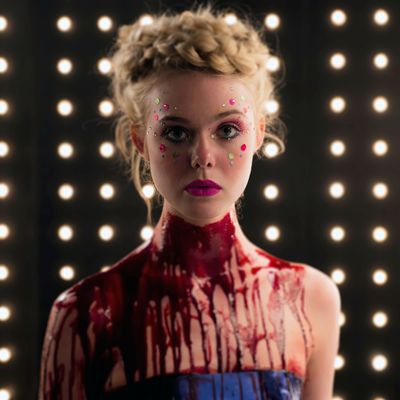
As 16-year-old model Jesse in The Neon Demon, Elle Fanning possesses the kind of magnetic beauty you can’t take your eyes off. You want to photograph her, plaster her face on sky-high billboards, drape her in couture gowns, and then maybe — just maybe — devour her flesh and drink her blood like an iron-rich smoothie.
If you’ve seen Nicolas Winding Refn’s last two films, Drive and Only God Forgives, you’ll know that style and mood tend to be far more important to him than plotting, but the basics of his new film are as follows: Elle Fanning plays a young model who has recently moved to L.A. People in the industry are transfixed by her beauty, and she quickly rises to the top of the modeling world. But she also inspires the envy and hatred of her fellow models Sarah and Gigi (Abbey Lee Kershaw and Bella Heathcote). Naturally this leads to necrophilia, cannibalism, and murder, all set to a stylish backdrop of neon, glitter, and ample strobe lighting.
The Neon Demon is a rare beast — a horror movie set in the fashion world — and yet it makes me wonder why there aren’t more movies like it. There are very few fashion-horror films (one example is the campy 1978 thriller The Eyes of Laura Mars), but fashion and horror seem like they could make very cozy bedfellows. For instance:
They’re both obsessed with contorting women’s bodies:
Throughout The Neon Demon, Gigi and Sarah constantly extol the virtues of plastic surgery and starvation in order to stay beautiful (as Gigi puts it: “plastic surgery is just good grooming”). It’s surprising we haven’t seen more body horror built around those tropes. After all, what is a “waist trainer” if not an implement straight out of a David Cronenberg movie? And is a skeleton not contouring taken to the logical extreme?
Everyone eats really weird things:
And for whatever it’s worth, I’m betting there’s more nutritional value in a human body part than there is in a green juice and handful of raw almonds.
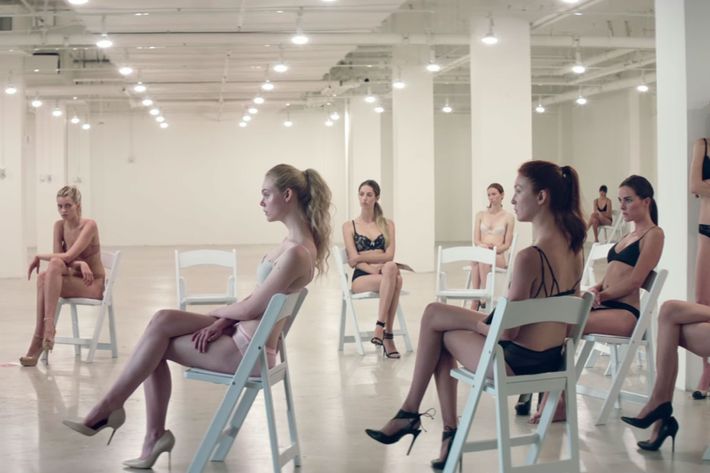
Femininity is scary:
The Neon Demon, Jessie’s female allure is consistently depicted as something disorienting, otherworldly, and, as she puts it, “dangerous.” It puts her in the company of wraiths like The Ring’s long-haired well-dweller, or Carrie’s bloody teen, or Rosemary with her demonic baby.
An emphasis on mood and atmospherics:
Fashion has often cribbed from horror, from the Mulleavy sisters’ Japanese-horror-inspired collections at Rodarte to Rick Owens’s recent human-centipede-inspired collection (kidding, sort of), while films like Picnic at Hanging Rock, Rosemary’s Baby, Clockwork Orange, and La Aventura have long served as fashion-world touchstones. The Neon Demon is a film that’s all about atmosphere, shot in glowing reds and cool blues, and using an array of lighting tricks to disorient us spatially. If Winding Refn ever decides to quit this whole film thing, I definitely think he has a future in runway-production design.
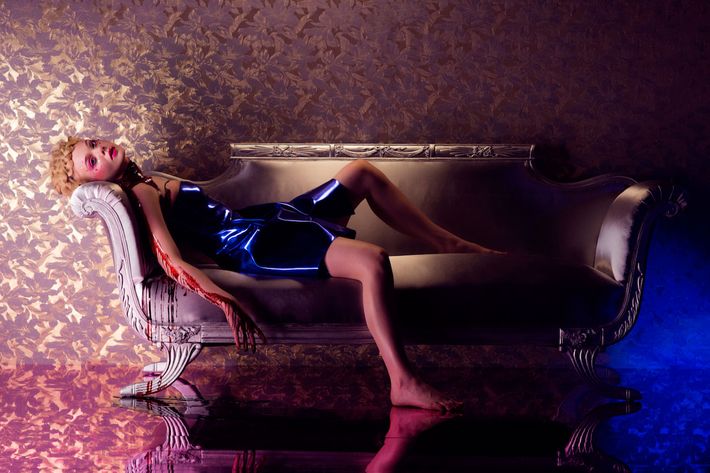
An obsession with death and violence:
In the first scene of the film, we see Jesse lying prone on a sofa in a metallic mini-dress, jewels around her eyes, a braid in her hair, blood gushing from her neck, and we wonder: Is she dead, or is this art? The shoot evokes countless violence-themed editorials: Jimmy Choo’s model tied up in a car trunk, Vogue Italia’s domestic-violence shoot, Vice’s suicide spread, Dolce & Gabanna’s “gang rape” ad, and Miley Cyrus’s Marc Jacobs ad with a corpse, to name just a few. As the film goes, on, Refn will force us to consider what fashion’s obsession with death looks like when pushed to its terrifying limit.
Youth is sacred:
Jessie lies about her age so she’s allowed to work (she bumps herself up from 16 to 19, prompted by Christina Hendricks’s encouraging casting agent), but it’s clear that her youth is what makes her such a potent object of desire. Horror, like fashion, is obsessed with the young: demonic children, teenage-slasher flicks, villains lusting after eternal youth. Sure, in horror, youth is generally a vessel for demonic possession and not just great gowns, but it’s really not that much of a stretch.
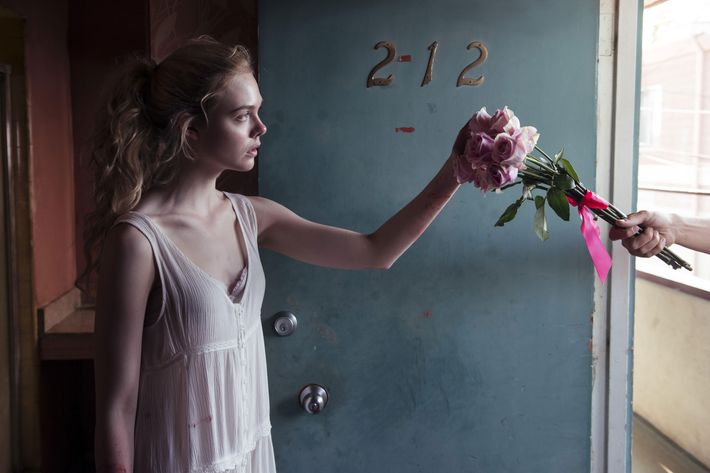
Models have a lot in common with vampires, zombies, clones, and other movie monsters:
Monsters in horror often rely on principles of the uncanny — figures that are like us, but just different enough to be unsettling — which is exactly what I think of when I see supermodels. Think about it: an army of super-tall, flawless, skeletal, youth-obsessed women, dressed identically, with a fixed gaze, marching slowly in unison through the dark? I either described the beginning of a zombie-apocalypse movie or the beginning of fashion week.
There’s often a final girl:
In fashion I think they call it “closing the show.”
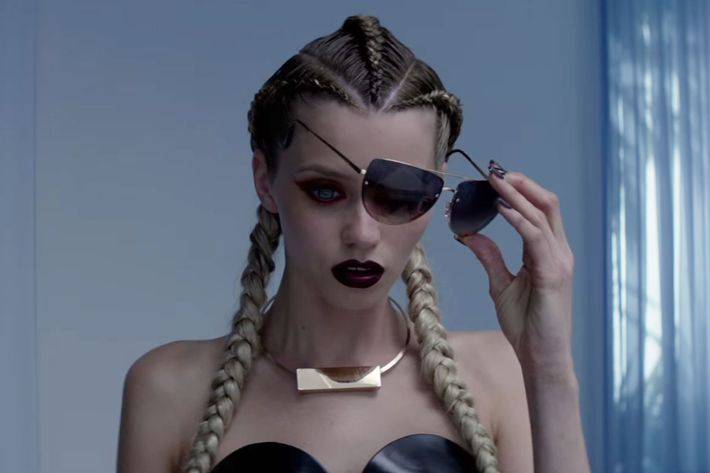
The industry abounds with creepy men:
I can’t think of a more literal manifestation of the predatory male gaze than the fashion photographer; and, true to form, a creepy Terry Richardson–esque photographer shows up early in the film to take photographs of Jessie naked. An archetypal horror villain if there ever was one.
They’re both cutthroat:
Just as The Devil Wears Prada turned fashion’s notoriously cutthroat industry dynamics into satire, The Neon Demon goes one step further and turns supermodels into literal murderers. Makes sense! We know that supermodels are great at throwing shade; why not trade those verbal barbs for actual weapons? What is the stiletto if not — to quote Camille Paglia — “modern woman’s most lethal social weapon?”
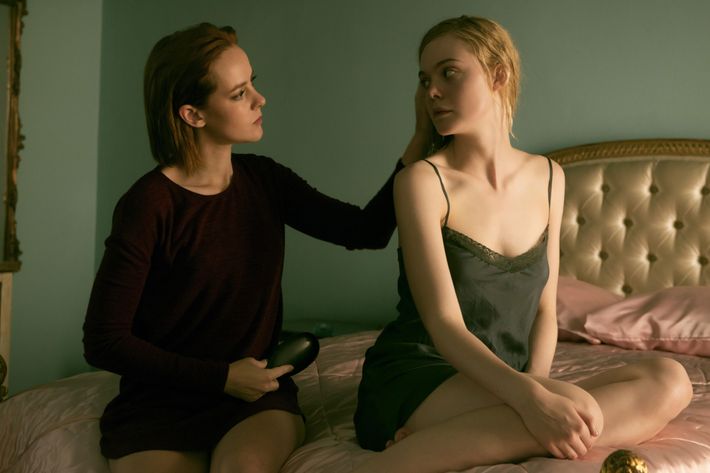
Fashion exists to disorient us:
Horror is a medium that preys on both our fears and desires, taking what society has repressed and manifesting it in monstrous form. Fashion is an industry built on repression: repressing the ugly, the imperfect, the gross realities of the human body. It’s also all-pervasive, manipulating how we think about ourselves and infiltrating our brain in subtle and insidious ways.
Politically, The Neon Demon ultimately feels like a pretty regressive horror film, with a male-driven camera lingering on the violent deaths of beautiful women. But there’s plenty of material to mine for the next director who takes it on. What might a good female director do with the subject? A truly subversive horror takedown might be exactly what the fashion industry needs.




